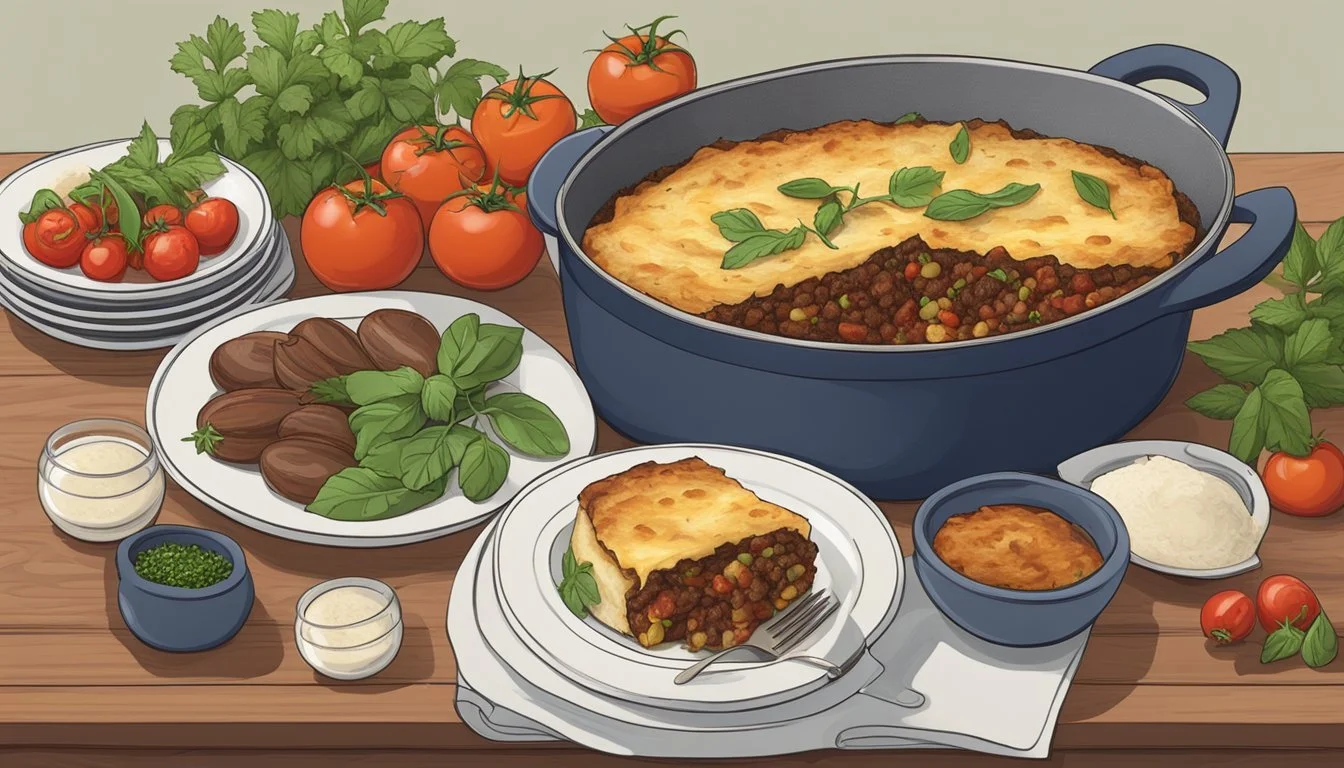Is Moussaka Gluten-Free?
Understanding the Traditional Dish's Ingredients
Moussaka is a traditional Greek dish known for its rich layers of eggplant (What wine goes well with eggplant?), meat sauce, and creamy béchamel topping. It is a comfort food that has become popular around the world. In its classic form, moussaka often contains elements that are not gluten-free, primarily due to the flour used in the béchamel sauce as well as possible fillers in the meat sauce. For those with celiac disease or a gluten intolerance, consuming gluten can lead to serious health complications, making it essential to adapt traditional recipes to fit a gluten-free diet.
The growing awareness of gluten-related disorders has led to an increased interest in gluten-free cooking and baking. As such, chefs and home cooks alike have devised ways to create gluten-free versions of dishes like moussaka. This is achieved by substituting traditional ingredients that contain gluten with alternatives, such as using gluten-free flour blends for thickening the béchamel sauce or ensuring that the meat is cooked with gluten-free seasonings. It's important when preparing gluten-free moussaka to take into consideration every ingredient to avoid cross-contamination with gluten.
With the right substitutions, moussaka can be transformed into a dish that those on a gluten-free diet can enjoy without concern. The integrity of the dish's flavors remains largely intact, meaning that the adjustments serve to make the dish accessible for all, without sacrificing the essence of the original recipe. As more individuals adopt a gluten-free lifestyle, the demand for versatile recipes like gluten-free moussaka continues to climb, showcasing the adaptability of traditional cuisines to modern dietary needs.
Understanding Moussaka
Moussaka is a rich, layered dish often described as the Greek answer to lasagna. It is renowned for its flavorsome complexity and comforting qualities.
Origin and Cultural Significance
Moussaka has its roots deeply embedded in Greek cuisine, considered a quintessential dish in Greece and across the Mediterranean region. It signifies more than just a meal; it embodies a tradition of family gatherings and warm hospitality endemic to Greek culture.
Typical Ingredients in Moussaka
Traditionally, moussaka is composed of sliced eggplant, potatoes, and a spiced meat filling, usually with lamb or beef. This foundation is layered and then topped with a creamy béchamel sauce, often enriched with egg and cheese. Ingredients like cinnamon, garlic, oregano, salt, and pepper are crucial for its distinctive flavor.
Key Ingredients:
Vegetables: Eggplant, Potatoes, Tomatoes
Protein: Lamb or Beef (sometimes in vegetarian versions, these are omitted)
Sauce: Flour-based Béchamel, Cheese, Egg
Seasonings: Cinnamon, Garlic, Oregano, Salt, Pepper
Fats: Olive Oil
The Role of Gluten in Traditional Recipes
In classical moussaka recipes, gluten plays a pivotal role within the béchamel sauce, where flour is used as a thickener. Additionally, some variations include breadcrumbs as a layering or topping ingredient, further introducing gluten to the dish.
Moussaka Variations
While the core elements of moussaka remain constant, many adaptations have emerged. Gluten-free moussaka omits flour in favor of cornstarch or other gluten-free alternatives for the béchamel sauce. Vegetarian and dairy-free versions are also available, substituting meat for lentils or mushrooms and dairy for plant-based alternatives. These variations cater to different dietary requirements while preserving the essence of the traditional Greek moussaka.
Gluten-Free Considerations
When preparing moussaka to be gluten-free, one must pay close attention to the ingredients used, suitable substitutions for gluten-containing elements, and the potential for cross-contamination.
Identifying Gluten in Ingredients
Moussaka typically contains several ingredients that may be sources of gluten. They often include flour and breadcrumbs, which are used in the béchamel sauce and sometimes in the meat filling. Gluten is a protein found in wheat, barley, rye, and their derivatives. A traditional moussaka recipe using these ingredients would not be safe for those with gluten sensitivities or celiac disease.
Substitutes for Gluten-Containing Ingredients
For a gluten-free moussaka, substitutions can be made without sacrificing taste or texture.
Flour: A gluten-free all-purpose flour blend is an effective replacement for regular wheat flour in the béchamel sauce.
Breadcrumbs: Gluten-free breadcrumbs or almond flour can be used as a binding agent in the meat layer.
Dairy: If one requires dairy-free in addition to gluten-free, dairy-free cheese can be used, though it is not a component in all recipes.
When selecting substitutes, it is essential to choose high-quality, certified gluten-free products, especially when it comes to gluten-free flour and breadcrumbs, to ensure the absence of gluten.
Cross-Contamination Concerns
Cross-contamination can occur during the preparation and cooking process, making a dish unsafe for those with gluten sensitivities even when gluten-free ingredients are used.
Use clean utensils and cookware dedicated to gluten-free cooking.
Prepare the gluten-free moussaka separately from gluten-containing foods.
Be vigilant when using shared kitchen equipment such as ovens. If possible, bake the gluten-free moussaka first to mitigate the risk.
In conclusion, with careful attention to ingredients, wise choices in gluten-free substitutes, and a watchful eye for cross-contamination, moussaka can be adapted into a delicious gluten-free dish.
Preparing Gluten-Free Moussaka
When creating gluten-free moussaka, meticulous selection of ingredients is paramount, ensuring that each component is safe for those with gluten sensitivities. Proper assembly and cooking techniques are crucial for achieving the traditional taste and texture of this classic dish.
Selecting the Right Ingredients
To ensure the moussaka is truly gluten-free, one must scrutinize all ingredients starting with the key components:
Eggplant slices: These are naturally gluten-free and form the foundational layers of the dish.
Ground beef: A common choice for the meat layer, ensuring it's free from additives that may contain gluten.
Tomato paste: Verify that it does not contain any gluten-containing thickeners.
Potato slices: If included, they offer a hearty, gluten-free layer.
One must also prepare a gluten-free béchamel sauce, using gluten-free flour or cornstarch as a thickening agent instead of traditional wheat flour.
Assembling the Dish
The methodical layering is what gives moussaka its unique texture and taste. Here's a simple guide to assembling the dish:
Prepare the meat sauce: Cook the ground beef, adding in gluten-free tomato paste and seasonings. Simmer until thoroughly cooked.
Prep the vegetables: Grill or roast the eggplant and potato slices until soft and slightly golden brown.
Construct the layers: In a greased casserole dish, begin with a layer of potatoes (if used), followed by eggplant slices, and then a generous amount of meat sauce.
Gluten-free béchamel: Spread a layer of the gluten-free béchamel sauce on top, repeating the layers if necessary, and finish with a final layer of béchamel.
Baking Instructions
To bake moussaka:
Preheat the oven to a temperature typically around 375°F (190°C).
Cover the assembled dish with foil and place it in the preheated oven.
Bake for about 40 minutes. Then, remove the foil and continue baking until the top layer turns a golden brown color, which may take an additional 30-40 minutes.
Total cook time should be approximately 70-80 minutes, but this can vary based on oven variations and layer thickness.
Before serving, it's important to allow the moussaka to rest for a short period to ensure the layers set properly.
Recipes and Cooking Tips
When preparing gluten-free moussaka, one needs to incorporate a careful selection of gluten-free ingredients alongside meticulous cooking techniques to achieve the desirable flavors and textures. Traditional moussaka includes layers of eggplant, a rich meat sauce, and a creamy béchamel topping, all of which can be made to cater to a gluten-free diet without compromising on the classic taste.
Gluten-Free Moussaka Recipe
For the gluten-free moussaka recipe, the ingredients are adjusted to exclude gluten-containing components. The typical meat sauce is prepared using ground lamb or beef, cooked in a frypan with seasonings such as garlic, onion, and cinnamon. The sauce should be thickened with a gluten-free flour substitute, like rice flour or cornstarch, instead of traditional wheat flour.
Cheesy Béchamel Sauce: To make the béchamel, one starts with a base of butter and gluten-free flour, gradually adding milk until it thickens. Season with salt, pepper, and a pinch of nutmeg. Once off the heat, a beaten egg can be stirred in along with grated cheese for extra richness.
Assembly: In a pre-greased baking dish, begin layering with grilled or fried eggplant slices, ensuring all utensils and surfaces are free from gluten cross-contamination. Next, spread the meat sauce, followed by the cheesy béchamel sauce. Repeat layers as necessary and finish with a final layer of béchamel.
Baking: Bake in an oven preheated to 375°F-400°F, depending on specific recipe instructions, until the moussaka is bubbling and the top has developed a golden-brown crust.
Cooking Techniques for Best Results
To achieve the best results for gluten-free moussaka, focus on technique:
Eggplant Preparation: Before assembling the moussaka, one should slice the eggplant and optionally salt the slices to draw out moisture. Then, use a griddle or a frypan to fry or grill them to a soft texture. This process intensifies the flavor and ensures the eggplant layers aren't soggy.
Meat Sauce Consistency: For an authentic texture, simmer the seasoned meat sauce until it's well-reduced and not watery. This prevents the layers from sliding apart and creates a firmer final dish.
Béchamel Smoothness: With the béchamel sauce, it's crucial to cook the flour and butter mixture long enough to remove any raw taste. Then, add milk slowly and stir constantly to avoid lumps. A steam basket is not usually required for this process.
Layering: Ensure that each layer of eggplant is covered with enough meat sauce and béchamel to avoid dry spots, yet not so much that it overwhelms the dish. Balance is key to a perfect moussaka.
By following these specific instructions and techniques, one can create a delightful gluten-free moussaka that is both satisfying and true to the dish's traditional roots.
Serving and Pairing Suggestions
Moussaka, the rich and savory Greek main course, pairs excellently with a variety of side dishes and beverages. These pairings can complement the flavors and enhance the overall dining experience while being mindful of the dish's caloric content.
Accompanying Side Dishes
Greek Salad: A classic Greek salad, featuring crisp vegetables like cucumbers and tomatoes, can be a refreshing counterpart to the dense moussaka. Feta cheese adds a tangy flavor while keeping servings balanced.
Steamed Vegetables: Lightly steamed vegetables such as zucchini or green beans provide a healthy, low-calorie option that complements the main dish without overwhelming the palate.
Wine and Beverage Pairings
Red Wine: A robust red wine, especially varieties from Greece such as Agiorgitiko or Xinomavro, can hold up to the rich flavors of the moussaka. The tannins in the wine help to cut through the richness of the dish.
White Wine: For those who prefer white wine, a full-bodied Greek white like Assyrtiko or a Chardonnay can provide a pleasing contrast to the moussaka's hearty layers.



